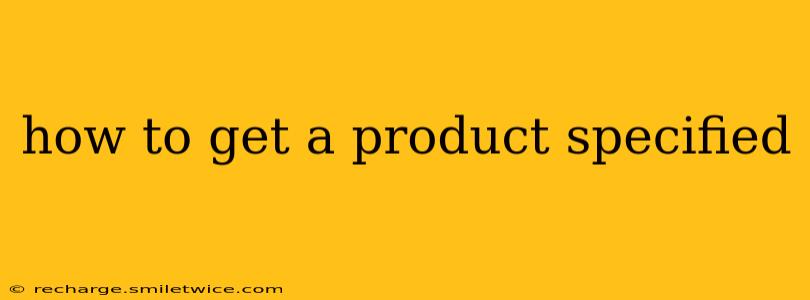How to Get a Product Specified: A Comprehensive Guide
Getting a product specified correctly is crucial for success in various fields, from engineering and construction to procurement and manufacturing. It ensures everyone involved is on the same page, reducing errors, delays, and costly rework. This guide will walk you through the essential steps involved in achieving clear and accurate product specifications.
What Does "Product Specified" Mean?
Before diving into the process, let's clarify what "product specified" entails. It means precisely defining the characteristics, requirements, and functionalities of a product to meet specific needs. This goes beyond simply naming the product; it involves detailing its materials, dimensions, performance parameters, quality standards, and any other relevant attributes. A well-specified product leaves no room for ambiguity or misinterpretation.
1. Define Your Needs and Requirements
The foundation of effective product specification lies in a thorough understanding of your needs. Ask yourself:
- What problem are you trying to solve with this product? Understanding the core purpose will guide your specifications.
- What are the key functionalities required? List every essential function the product must perform.
- What are your performance expectations? Define metrics for measuring success (e.g., speed, efficiency, durability).
- What are your budget constraints? This will influence material choices and manufacturing processes.
- What are the environmental considerations? Think about sustainability, recyclability, and potential impact.
2. Research and Identify Potential Products
Once you've defined your needs, research existing products that might fit the bill. Look at competitor offerings, explore industry standards, and consult with experts. This research will help you understand what's feasible and available, informing your specifications.
3. Develop Detailed Specifications
This is the heart of the process. Your specifications should cover:
- Materials: Precisely specify the materials to be used, including their grades and properties.
- Dimensions and Tolerances: Provide exact measurements with acceptable variations.
- Performance Parameters: Define measurable criteria for performance, including testing methods.
- Quality Standards: Reference relevant industry standards (e.g., ISO, ASTM) or specify your own internal standards.
- Safety Requirements: Address any safety concerns and compliance with regulations.
- Packaging and Labeling: Outline requirements for packaging, shipping, and labeling.
4. Choose the Right Specification Method
Several methods exist for specifying products, depending on the context:
- Descriptive Specifications: Describe the product's characteristics and functionalities in detail using plain language.
- Performance Specifications: Focus on the product's performance requirements without dictating the specific design or materials.
- Reference Specifications: Refer to existing standards or specifications (e.g., industry standards, previous successful projects).
5. Review and Iterate
After drafting your specifications, have them reviewed by multiple stakeholders. This helps to catch errors, identify omissions, and ensure clarity. Iteration is key to achieving a finalized and accurate specification.
6. Secure Approvals
Obtain necessary approvals from relevant parties, such as engineering, procurement, and quality control teams. This formalizes the specification and ensures everyone is working from the same document.
7. Manage Changes
Throughout the process, track any changes to the specifications using a version control system. This prevents confusion and maintains a clear record of revisions.
How to Specify Different Product Types?
The specifics of product specification will vary based on the product's nature. However, the fundamental principles remain the same: clarity, precision, and completeness. For example, specifying a piece of software would differ from specifying a building material, focusing on different aspects (e.g., code functionality vs. strength and durability).
How Can I Ensure My Product Specifications Are Accurate?
Accuracy is paramount. Use precise language, avoid jargon where possible, and include visual aids (e.g., diagrams, drawings) whenever helpful. Employ a structured format and consistently apply units of measurement. Thorough testing and validation should always follow the finalized specifications.
By following these steps and adapting them to your specific needs, you can ensure your products are accurately specified, leading to successful outcomes and reduced risks. Remember that clear communication and collaboration are essential throughout the entire process.
